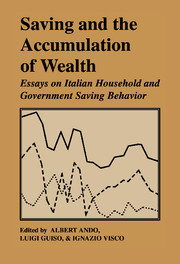Book contents
- Frontmatter
- Contents
- Foreword by Antonio Fazio
- List of contributors
- List of figures
- List of tables
- Acknowledgments
- Introduction
- I Saving trends, government deficit and demographic changes
- II Life-cycle saving and precautionary motives
- III Borrowing constraints, intergenerational transfers and bequests
- 9 Saving and borrowing constraints
- 10 Durables and non–durables consumption: evidence from Italian household data
- 11 Intergenerational transfers and capital market imperfections. Evidence from a cross–section of Italian households
- 12 Bequests and saving for retirement. What impels the accumulation of wealth?
- Appendixes
- Index
9 - Saving and borrowing constraints
Published online by Cambridge University Press: 05 May 2010
- Frontmatter
- Contents
- Foreword by Antonio Fazio
- List of contributors
- List of figures
- List of tables
- Acknowledgments
- Introduction
- I Saving trends, government deficit and demographic changes
- II Life-cycle saving and precautionary motives
- III Borrowing constraints, intergenerational transfers and bequests
- 9 Saving and borrowing constraints
- 10 Durables and non–durables consumption: evidence from Italian household data
- 11 Intergenerational transfers and capital market imperfections. Evidence from a cross–section of Italian households
- 12 Bequests and saving for retirement. What impels the accumulation of wealth?
- Appendixes
- Index
Summary
Introduction
Recent research on the evolution of the Italian saving rate has suggested that capital market imperfections are among the probable explanations for the high rate of saving in Italy. Reasonable as it is, the borrowing constraints hypothesis can only be accepted or rejected on empirical grounds. In the case of Italy, Jappelli and Pagano (1988), Guiso and Jappelli (1994) and Guiso, Jappelli and Terlizzese (1994) have attempted to evaluate the impact of capital market imperfections on households' saving decisions and have substantiated their claims by means of a number of empirical tests designed to assess the effect of credit market imperfections on the saving behavior of Italian households.
Their work relies crucially on exogenously given criteria to identify liquidity–constrained consumers. For example, in Jappelli and Pagano (1988), the sample selection rule (i.e. the arbitrary threshold above which liquidity constraints are supposed to operate) coincides with a propensity to save below 15 percent. Alternatively, they rely (along with Guiso and Jappelli, 1994) on direct information (available in the Bank of Italy Survey of Household Income and Wealth, SHIW) regarding consumers turned down (or expecting to be turned down) in the market for consumer credit. Finally, to assess the impact of mortgage market imperfections Guiso et al. (1994) assume that homeowners are not constrained in the mortgage market.
- Type
- Chapter
- Information
- Saving and the Accumulation of WealthEssays on Italian Household and Government Saving Behavior, pp. 273 - 304Publisher: Cambridge University PressPrint publication year: 1994



